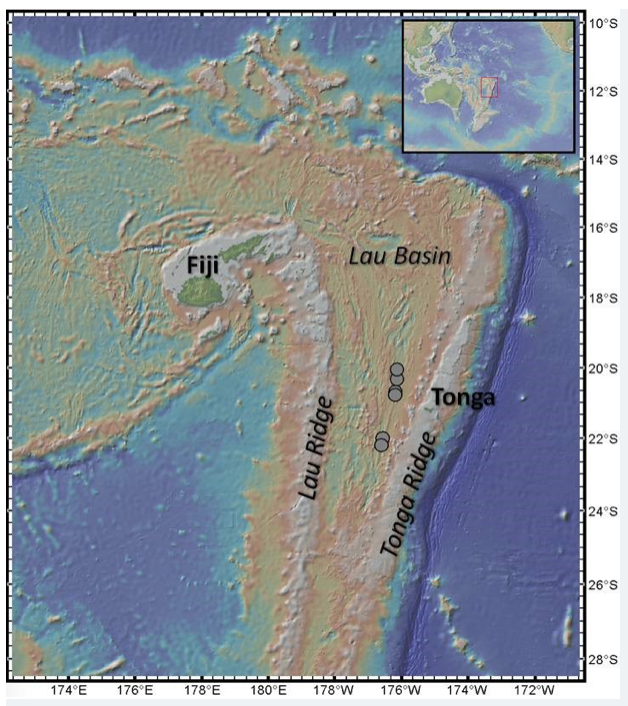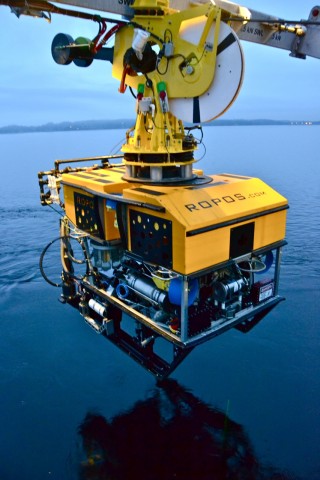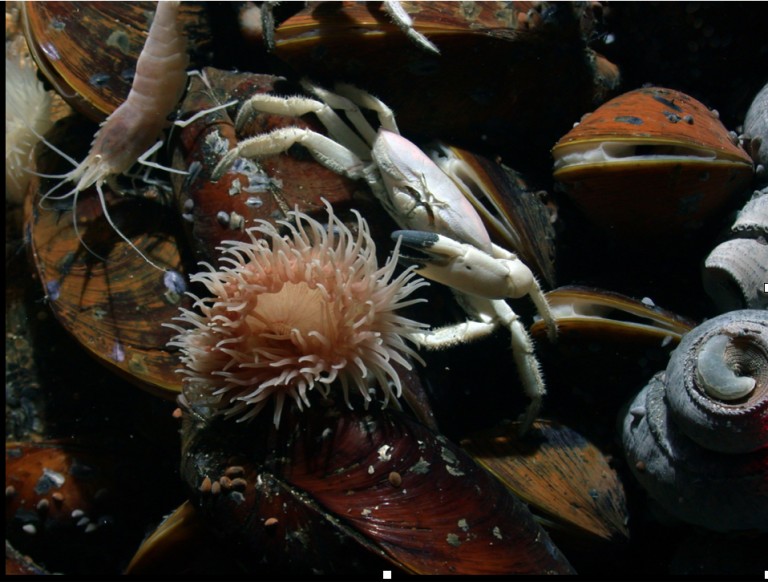In the deep sea, hydrothermal vents are biologically important, harboring massive animal communities at densities that make them one of the most productive ecosystems on Earth. All this biomass exists thousands of feet below the sea surface and, unlike most communities, which rely on sunlight, the food web of hydrothermal vents is based on tiny chemosynthetic microbes (bacteria) which derive their energy from “breathing” vented chemicals. Hydrothermal vents typically arise where the movement of the plates that make up the surface of the Earth split and fissure, allowing geothermally heated water to escape through the planet’s crust (chemically enriched water that may reach temperatures of over 640°F).
Spreading centers in Western Pacific back-arc basins are geologically unique and the frequency of their tectonic or volcanic events are not well documented. The hydrothermal vent communities in these regions are also distinct, hosting endemic fauna, which are species that are not found anywhere else. Recent studies have further shown that these communities may harbor cryptic species that have yet to be described.
Mining and the need for research
Potential environmental impacts of industrial mining in deep sea environments remains poorly constrained, and our limited knowledge about hydrothermal vent ecosystems in the Western Pacific back-arc basins makes it difficult to create conservation strategies to effectively manage anthropogenic effects in this area. To date, Papua New Guinea, Fiji, and the Kingdom of Tonga have granted exploration licenses in their territorial waters for industrial mining of polymetallic sulfide deposits around hydrothermal vents. Current mining strategies and management plans are largely based on patterns and predictions derived from studies and observations at mid-ocean ridge vents in the Pacific (i.e., East Pacific Rise), which are likely not relevant to the geologically and biologically distinct hydrothermal vents of the Western Pacific. This is one of the primary reasons why the research vessel Falkor traveled to Fiji in April 2016, and embarked on an expedition to obtain new knowledge necessary for sustainable management of these natural resources.
The Vent Life expedition

A team of interdisciplinary scientists led by principal investigators Dr Charles Fisher from Pennsylvania State University, Dr Peter Girguis from Harvard University, Dr Vicki Ferrini from Columbia University’s Lamont Doherty Earth Observatory, and Dr Roxanne A. Beinart from Woods Hole Oceanographic Institution embarked on a 28-day expedition onboard the R/V Falkor. The team revisited long-term study sites (some established over a decade ago) as well as newly discovered hydrothermal vent fields on the Eastern Lau Spreading Center and Valu Fa Ridge between Fiji and the Kingdom of Tonga.

The remotely operated vehicle (ROV) ROPOS traveled up to nine thousand feet to the deep seafloor of the Lau Basin. Once on the bottom, the extremely versatile ROV performed a range of scientific tasks including visual and sonar surveys, collecting specimens and samples, and taking environmental measurements. All the research conducted on this hydrothermal vent expedition was facilitated by the remotely operated vehicle (ROV) ROPOS. From a sensor onboard ROPOS, scientists conducted high-resolution bathymetric surveys at six hydrothermal vent fields and looked for evidence of tectonic or volcanic events that alter the environment. These high-resolution bathymetric maps also provided insight into geological processes for more than two dozen long-term study sites members of the team established in 2005 and 2006. At each site, high-resolution two- and three-dimensional mosaics and advanced in situ chemical and temperature sensors were used to document the fine-scale spatial ecology of hydrothermal vents, the effect vent animals have on the local water chemistry, and temporal ecosystem changes.
In conjunction with the field surveys and samples, scientists studied several of the most abundant vent species using high pressure aquaria and molecular tools to better understand the influence of particulate load on respiration (a potential influence of deep sea mining), symbiont activity, and survival. The observations contributed to predictive models for species-specific tolerance to changing conditions.
Benefits of this research

This extensive study provided new insights into the level of volcanic and tectonic activity in the Lau basin, the ecology of hydrothermal vent communities, and the sensitivity of vent animals to potential anthropogenic stressors. The unique longevity of research at these study sites by the team provides a baseline with which to compare their findings, allowing them to make a more informed assessment of the potential impact of mining in the region, and provide a baseline for robust interpretation of post-mining monitoring of environmental impacts. Fisher, Girguis, Ferrini and Beinart believe that the results from these studies can inform impact assessment protocols and policies at deep sea sites in the Western Pacific biogeographic province that may be the target of future mining.
This material is based upon work supported by the National Science Foundation under Grant Number NSF OCE 1537807
Any opinions, findings, and conclusions or recommendations expressed in this material are those of the author(s) and do not necessarily reflect the views of the National Science Foundation
Data & Publications
The resulting shipboard dataset is being stored at the Rolling Deck to Repository and is now available.
The Integrated Real-time Logging System logbook from each ROPOS dive is available to the public upon request.
Processed and Gridded Bathymetry, XBT data, Fluid Chemistry, Photomosiacs, and ROV ROPOS data and imagery are available at the Marine Geoscience Data System portal.
Preserved voucher specimens were deposited in the Harvard Museum of Natural History’s Collection and made available to the public. Links to each specimen guide can be found here.
Tissue samples for DNA analysis have been deposited into Ocean Genome Legacy Center. Here is a list of the specimens deposited. Please note the specimen ID and contact OGL so they may send you a sample.
Identifications from biological samples collected with ROV ROPOS during the cruise are archived in BCO-DMO.
16s rRNA gene amplicon sequencing data of the bacterial symbionts associated with Ifremeria nautilei from hydrothermal vents in the Lau Basin (Tonga) is available at NCBI.
16s rRNA gene amplicon sequencing data of the bacterial symbionts associated with Alviniconcha species from hydrothermal vents in the Lau Basin (Tonga) is available at NCBI.
You can search Nucleotide Accension Numbers here. Accension Numbers are: MT131487–MT131781 (COI), MT130994–MT131149 (12S), MT146898–MT147385 (H3), MT148092–MT148633 (ATPSa), MT148634–MT149209 (ATPSb), MT147386–MT148091 (EF1a), and MT137388–MT137420 (16S).
Genetic sequence data deposited in the National Center for Biotechnology Information under BioProjects PRJNA523619, PRJNA526236, PRJNA473256, PRJNA473257, PRJNA610289, PRJNA610290, PRJNA763784 and PRJNA767887.
- Cruise Report: Ecosystem Dynamics of Hydrothermal Vent Communities
- Du Preez, C. (2017). Deep Sea Exploration: Filming Battles, Behavior, Bangs, & Bacon. Invited Lecture to Harvard University, Cambridge, MA, USA.
- Du Preez, C. and C. Fisher. (2017). Remarkable Decadal Stability at Lau Basin Hydrothermal Vents (Southwest Pacific). Oral Presentation at 6th International Symposium on Chemosynthesis-Based Ecosystems, Woods Hole, MA, USA.
- Du Preez, C., and C. Fisher. (2017). Monitoring Spatial and Temporal Variability at Hydrothermal Vents: A Decade of Repeated Centimeter-scale Mapping. Oral Presentation at Marine Imaging Workshop, Kiel, GERMANY.
- Du Preez, C. and C. Fisher. (2018). Long-Term Stability of Back-Arc Basin Hydrothermal Vents. Frontiers of Marine Science, 5:54, doi: 10.3389/fmars.2018.00054. [This article has been published as OPEN ACCESS].
- Garvin, J., Slayback, D., Ferrini, V., Frawley, J., Giguere, C., Asrar, G., and Anderson, K. (2018). Monitoring and Modeling the Rapid Evolution of Earth's Newest Volcanic Island: Hunga Tonga Hunga Ha'apai (Tonga) Using High Spatial Resolution Satellite Observations. Geophysical Research Letters, 45, doi: 10.1002/2017GL076621. [This article has been published as Open Access].
- Russell, S., Pepper-Tunick, E., Svedberg, J., Byrne, A., Ruelas Castillo, J., Vollmers, C., et. al. (2020). Horizontal transmission and recombination maintain forever young bacterial symbiont genomes. PLOS Genetics, 16(8): e1008935, doi:10.1371/journal.pgen.1008935. [This article is published as OPEN ACCESS].
- Breusing, C., Johnson, S., Tunnicliffe, V., Clague, D., Vrijenhoek, R., and Beinart, R. (2020). Allopatric and Sympatric Drivers of Speciation in Alviniconcha Hydrothermal Vent Snails. Molecular Biology and Evolution, 37(12), 3469-3484, doi: 10.1093/molbev/msaa177. [This article has been published as OPEN ACCESS].
- Breusing, C., Mitchell, J., Delaney, J., Sylva, S., Seewald, J., Girguis, P. and Beinart, R. (2020). Physiological dynamics of chemosynthetic symbionts in hdyrothermal vent snails. The ISME Journal, 14, 2568-2579, doi: 10.1038/s41396-020-0707-2. [This article is published as OPEN ACCESS].
- Breusing, C., Johnson, S., Mitarai, S., Beinart, R. and Tunnicliffe, V. (2021). Differential Patterns of Connectivity in Western Pacific Hydrothermal Vent Metapopulations: A Comparison of Biophysical and Genetic Models. Evolutionary Applications, 00, 1-14, doi: 10.1111/eva.13326. [This article has been published as OPEN ACCESS].
- Breusing, C., Castel, J., Yang, Y., Broquet, T., Sun, J., Jollivet, D., et al. (2022). Global 16S rRNA Diversity of Provannid Snail Endosymbionts from Indo-Pacific Deep-sea Hydrothermal Vents. Environmental Microbiology Reports, doi: 10.1111/1758-229.13051. [This article has been published as OPEN ACCESS with support from SOI].
- Breusing, C., Genetti, M., Russel, S., Corbett-Detig, R., and Beinart, R. (2022). Horizontal Transmission Enables Flexible Associations with Locally Adapted Symbiont Straints in Deep-sea Hydrothermal Vent Symbioses, PNAS, 119 (14), doi: 10.1073/pnas.2115608119. [This article will be available OPEN ACCESS on June 1, 2022 with support from SOI].
- Breusing, C., Hagen Klobusnik, N., Hauer, M., Beinart, R. (2022). Genome Assembly of the Chemosynthetic Endosymbiont of the Hydrothermal Vent Snail Aliviniconcha adamantis from the Mariana Arc. G3 (Bethesda), 12 (10), doi: 10.1093/g3journal/jkac220. [This article has been published as OPEN ACCESS].
- Breusing, C., Xiao, Y., Russel, S., Corbett-Detig, R., Li, S., Sun, J., et al. (2023). Ecological differences among hydrothermal vent symbioses may drive contrasting patterns of symbiont population differentiation. mSystems 8(4), doi: 10.1128/msystems.00284-23. [This article has been published as OPEN ACCESS].
In the News
Hydrothermal studies
The Fiji Times • April 23nd, 2016
Life In The Deepest Places Of Our Ocean
Fiji Sun • April 26th, 2016
Researchers Explore Pacific Oceans Hidden Deep Secrets
Live News • April 26th, 2016
Researchers Explore Pacific Oceans Hidden Deep Secrets
Foreign Affairs • April 26th, 2016
Researchers explore Pacific Ocean’s hidden deep ‘secrets’
Asia Pacific Report • April 26th, 2016
Scientists Explore Earth’s Newest Land Using Advanced, High-Resolution 3D Mapping
PR Web • May 3th, 2016
Scientists Explore Earth’s Newest Land Using Advanced, High-Resolution 3D Mapping
Benzinga • May 3th, 2016
From Top to Bottom: Scientists Map a New Island Volcano
State of the Planet • May 4th, 2016
Researchers Map Newest Island in Tonga Using High-Resolution 3D Mapping Technology
Nature World News • May 4th, 2016
New Island Volcano Mapped
Laboratory Equipment • May 5th, 2016
Tonga: quelle sera la durée de vie de la nouvelle île?
Radio Australia – Australian Broadcast Corporation • May 7th, 2016
Tonga’s newest island could provide otherworldly insights
ABC Pacific Beat • May 7th, 2016
The Story of Hunga Tonga Hunga Haapai Island in the Kingdom of Tonga
Apogeo Spatial • June 9th, 2017
Watch the fascinating birth of a new island in Tonga
Mashable • December 13th, 2017
Birth of new island could offer NASA clues about life on Mars
RT • December 11th, 2017
The Birth of a New Island
Cyber Report • December 11th, 2017
NASA Shows New Tongan Island Made of Tuff Stuff, Likely to Persist Years
NASA • December 11th, 2017




